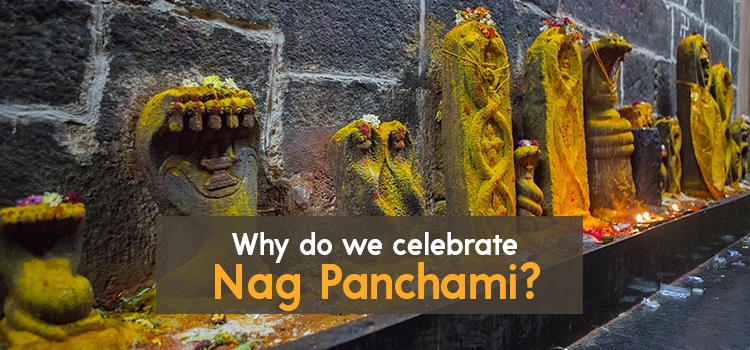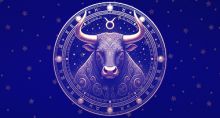Why do we celebrate Naga Panchami?
Naga Panchami: Festival of Snakes:
Naga Panchami is a traditional Hindu festival that honors snakes. Hindus in India, Nepal, and some other countries celebrate the festival. It has great significance for devotees of Shiva and is celebrated on the fifth day of Shukla Paksha, or the bright half of the lunar month, in Shravan (July/August) month. There are many interesting legends about this festival.
As per Hindu beliefs, snakes reside in Patal Lok, the seventh (and lowest) of all the seven realms below the earth. The seventh realm is called Naga Loka, the kingdom of the Nagas. People seek the blessings of snakes for the welfare of the family. Traditionally, a serpent’s image is made of silver, wood, or stone and is worshipped on Naga Panchami. In some places, people fast on this day and offer food to Brahmins. It is believed that the pooja for snakes will grant protection against snake bite.

Legend of Naga Panchami:
People also worship real snakes during Naga Panchami festival. Large fairs are held in many places across the country on this day. Interestingly, some things are considered taboo on Naga Panchami. They include digging the earth, cutting, and frying food. While digging is not done to prevent harming snakes which reside in holes under the earth, the ban on frying may be related to the fire which annihilated many snakes during the Sarpa Satra or Yagna conducted by Janamejaya, the son of King Parikshit, to avenge his father’s death by snake bite. Many snakes perished in the fire. The entire snake population would have been wiped out but for the intervention of Goddess Manasa’s son, Astika. It was he who went to the Yagna site and persuaded Janamejaya to stop the Yagna and save the snakes.
Yet another legend is associated with Krishna and his encounter with the poisonous serpent, Kaliya, which lived in the Yamuna river. The young Krishna managed to subdue the serpent by dancing on its hood. This incident is called ‘Kaliya Mardhanam and is believed to have occurred on this day.
In Hinduism, snakes are believed to be divine beings and are referred to as Naga Devatas. They are also associated with gods like Shiva, Subramanya, and Vishnu. Snakes are also important in Vedic Astrology. The two lunar nodes, Rahu and Ketu, are depicted as serpents. While Rahu represents the head of the snake, Ketu represents its tail. Rahu and Ketu are the snake planets that have very significant roles to play in a person’s horoscope. If they are afflicted, the person is said to have Sarpa Dosha or Naga Dosha. There is also a dosha called Kalasarpa Dosha. Such doshas can have many adverse effects on a person’s life. They include delay in marriage, childbirth, unhappy marital life, litigation, health problems related to skin, eyes, ears, throat, etc. Hence, people fear these two planets and try to propitiate them through poojas for these planets as well as snakes.
Snake worship in Kerala:
In Kerala, snake worship has existed since ancient times. Long ago, many affluent people had ‘sarpa kavus’, or sacred groves where snakes resided, on their land. They used to worship the snakes who lived on their land, believing that it brought them prosperity and auspiciousness. But later, many of these sarpa kavus were destroyed to build houses or other structures, and the later generations no longer cared to worship the snake deities. Many such people who consult astrologers for various problems in their lives are told that the source of their problems lies in the neglected or destroyed sarpa kavus or sacred groves. It has been observed that people who live in houses built on the land where snake pits have been demolished, often suffer from ill-health.
Kerala even has temples dedicated to snake worship, like the famous Mannarassala temple in Haripad, which has a sarpa kavu as well. In many Kerala villages, there is also the tradition of Pulluvan Pattu, which is a kind of snake worship. The Pulluvars who perform this worship belong to the lower castes and are believed to have a close bond with serpents. The snake gods are their presiding deities, and they offer sacrifices and sing songs. People from higher castes invite them to come and perform the Pulluvan Pattu at their homes, as they believe it brings them good fortune and prosperity.
Some Reasons for Snake Worship
Though many people regard snakes with fear and aversion, they have a crucial role to play in the ecosystem. Farmers benefit from snakes as they kill pests like rodents. Also, snakes are reclusive creatures and avoid human beings, attacking only when they are in danger. During the monsoons which arrive in June and continue till September, snakes often leave their holes, which become flooded and enter the homes of human beings in the vicinity. Many people, therefore, celebrate Naga Panchami to placate snakes and hoping that they will not have to face any harm from them. People observe certain rituals on this day. They may pour milk into the snake pits and offer flowers. It is a common belief that snakes drink milk. Some offer things like turmeric and eggs too.
Thus, we can see that there are many reasons why Naga Panchami is an important festival in India and for Hindus. Some of these reasons may have to do with astrology, and others may have to do with faith. And some reasons may just have to do with the universal and basic instinct of self-preservation.



















